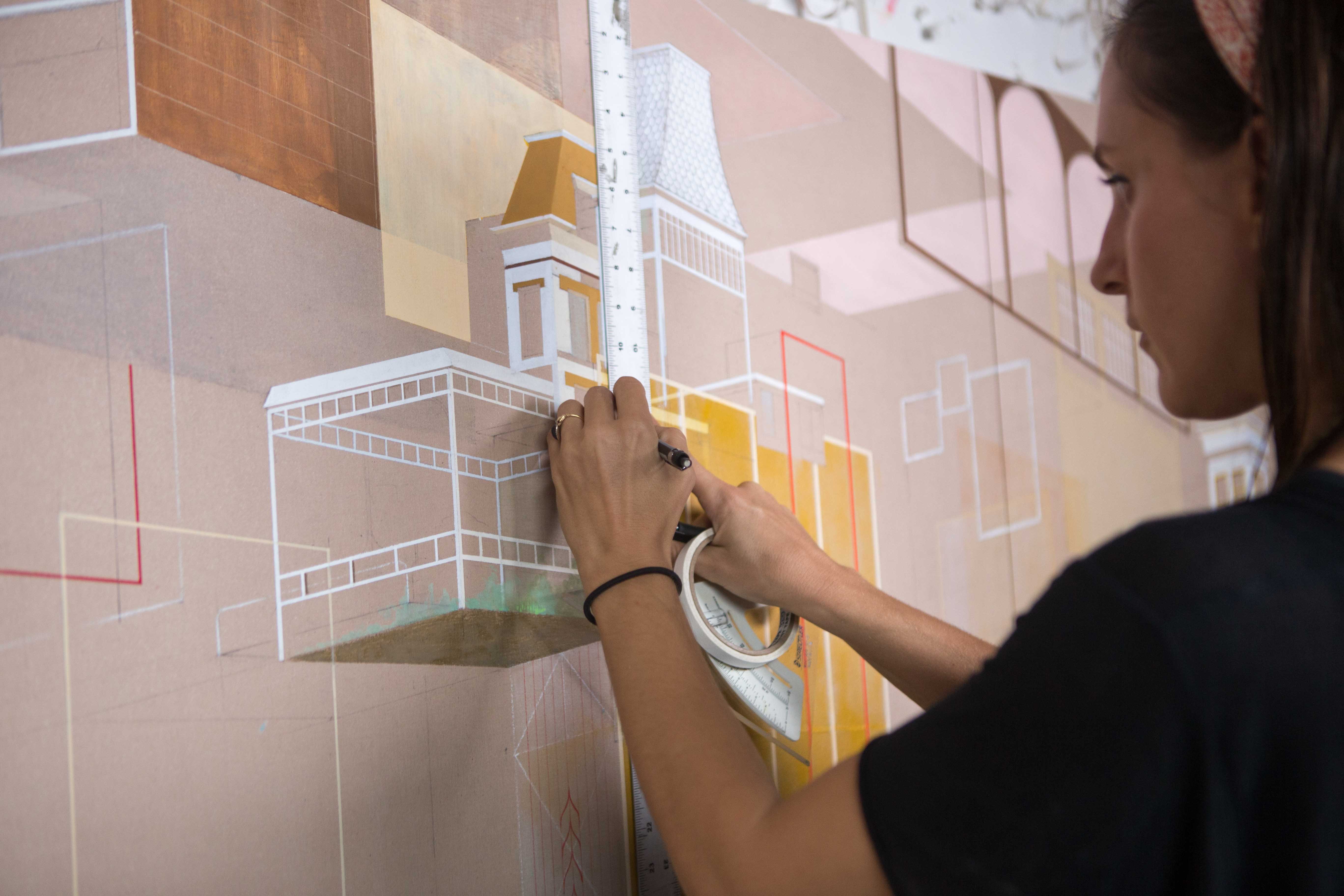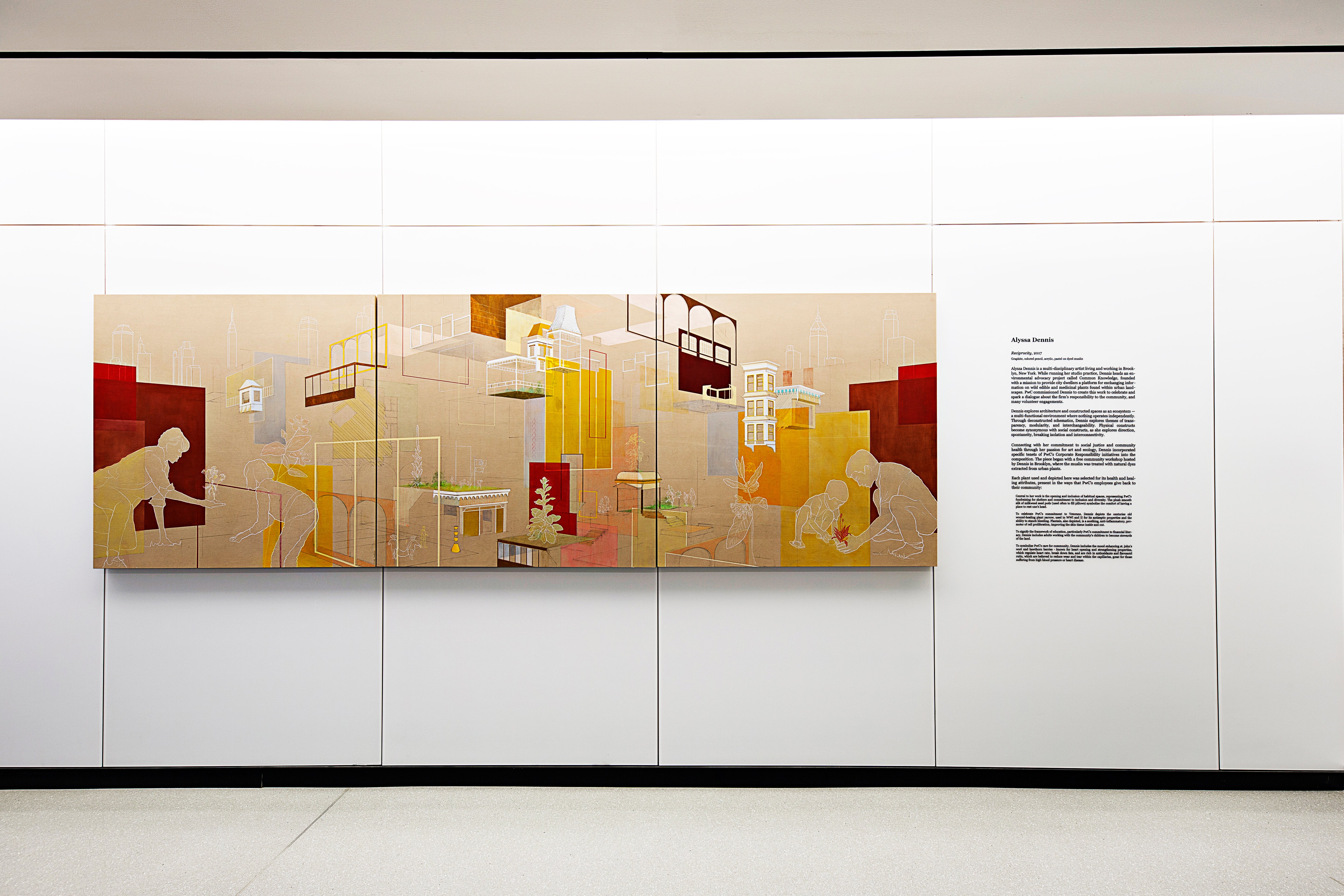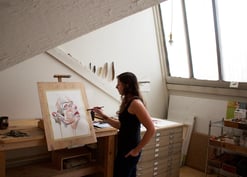As an artist exploring architecture and constructed spaces, Alyssa Dennis has always favored drawing on paper. The sensation of graphite, colored pencil, or gouache as it meets the absorbent surface of paper is a feeling that she can’t give up. Despite her forays into other mediums in order to push her ideas further, the process of drawing always excites her the most.
With repeated acts of sketching and erasing, Alyssa produces a layered effect of lines and perspectives that interact with each other in a dance between permanence and impermanence. The visual outcome is one of movement and modularity. Her architectural drawings demonstrate that everything we come into contact with is part of a living, breathing and infinitely changing organism.
In this interview Alyssa shares more about her routine, creative process, and career as an artist.
Can you tell us about your journey to become a professional artist?
I went to an arts high school in Baltimore called Carver Center. ...the best place ever! When I found out about their art program I knew instantly it was for me. Even before high school I was attracted to and admired those that were interested in things that were hidden or only understood in some kind of poetic code. Attending art school seemed like a dream. That was who I was and who I wanted to be. I somehow wanted to know all of life’s secrets and thought art would lead the way.
How would you describe your work?
My work is about creating a conversation around regenerative, ecologically conscious building practices. While I visualize alternative as well as conventional construction methods within the work, I try and allow a very intuitive imaginative outcome where habitual structures are forever changing and adjusting: the same way ecosystems modify and adapt continuously.
In a world full of highly planned and heavily regulated contemporary building and urban planning, I am interested in activating intuitively constructed spaces that exist outside of our conscious mind. I am continuing to expand this interest into urban landscaping to question how and where we access food and medicine. I am also attempting to highlight the importance of cultivating reciprocity with our surrounding ecosystem. From a Western perspective, the essential needs of food and shelter are systematically less and less instinctive. We are trading generations of inherited traditional knowledge about how to interact with nature for commodified convenience. As a result we are losing the very imperative ability to have a symbiotic relationship with our environment. My aim is to inspire an intuitive biological system of design and a kind of re-imaging of how and what we build.  Can you tell us about your process for creating a work?
Can you tell us about your process for creating a work?
I very rarely do preliminary sketches. The finished work always contains any preliminary attempt because I want the finished work to have shadows of where I've changed my mind or decided to edit. In this way nothing is ever completely edited out but only layered over or integrated. A blank sheet of paper is like a seed... It holds such enormous potential. I like to start with a color palette in mind and a few images I would like to work with. I’ll then draw a random mixture of vertical, horizontal and perspective lines to then see if there is something within this loose approach that I hadn’t considered previously. I might then layer in a building I saw in my neighborhood or from a reference photo. I used to only take pictures of buildings I saw and still do but find it much more helpful to make a note of the cross street and then revisit the site via Google Maps.
It is important for me to deeply investigate the content I explore within the work. For instance, I became interested in regenerative building methods 17 years ago and instead of doing research in the traditional sense of going to the library, I immersed myself by enrolling in several hands-on workshops and subsequently got a job as a laborer building a 27,000 sqft straw-bale and adobe structure in 2007. My work since then has been informed by this experience as well as my visits to other forms of ‘alternative’ architecture. In addition to learning various forms of regenerative building, I’m now studying to be a clinical herbalist as both a way to influence lifestyle shifts and once again to speak about our collective autonomy around our basic necessities of food, medicine and shelter. I am currently working on a project about ‘invasive’ plants which thrive within the urban landscape. Every one of these ‘invasive’ species are given a negative label because they interfere with modern industry, infrastructure planning and development.
When looking for inspiration, what resources do you turn to?
My continued search for inspiration comes from my immediate surroundings; things I see or come in contact with, whether it is an abandoned lot, and unopened flower or the way the light casts itself at dusk. I feel this is a very intentional, even rebellious act. As a culture we do not do this enough. We constantly distract ourselves with what is new, foreign or exotic. The common and the everyday bores us, but it’s simply a symptom of not looking close enough. Modern convenience has distracted us from having a relationship with place. I am attached to creating ways of pushing a paradigm shift in how we relate and interact with the very land we inhabit. I also am very inspired by other artists work and the efforts others make to manifest their dream.
Walk us through a typical day in your studio. What is your routine?
As an artist it is hard to develop a typical routine. Once you sign up to be an artist you sign up to be a person who wears many different hats. You juggle creative ideas with being a business owner. I used to think that it was important to be in the studio 8 hours a day 5 days a week in order to have a productive studio practice. I managed to keep this kind of schedule for about 6 months only to realize that working alone in a studio for 40 hours a week did not form my best ideas or make my best work. In the past couple of years I’ve come to accept that this amount of time spent in the studio is not where my productivity and seeds of good ideas come together. I now spend a good portion of my time answering emails and doing business related work. Aside from that, I am currently doing active experiential research like attending herb school and engaging with my community and surroundings, along with spending about 4 hours a day in the studio. 
For emerging artists, finding the right rhythm to be productive in the studio can be a challenge, what advice do you have for staying productive and focused?
Figure out what is most important to you and follow that at every turn. If you can figure out what is most important to you then rhythm and productivity will follow.
What is your advice for combating creative block?
Every time I relax and take time for self-care my ideas start forming like a puzzle putting itself together. It honestly feels like magic. If you have a creative-block it just means you need to get yourself out of your own head. Take a break :)
As an artist, how do you measure your success?
The biggest success for me is when a person I don’t know well or have never even met resonates with my work in some way and reaches out to tell me. Art is a language and communication device. There are many languages that we speak which do not require words nor involve the mind. When someone recognizes this language that truly is the greatest feeling of success.  What advice do you have for artists who are beginning to build their career? Have there been any habits or strategies that you have adopted that you feel have created more opportunity or visibility for your work?
What advice do you have for artists who are beginning to build their career? Have there been any habits or strategies that you have adopted that you feel have created more opportunity or visibility for your work?
Show your work in spaces where you feel a gallerist, dealer or representative really respects and understands what you are doing. Find a city that is cheap enough to live in that also supports artists. You want to be able to free up at least 20-25 hours a week to work on your ideas in your desired medium. If you can give yourself at least 2-5yrs of this you’ll have a body of work that can carry you to the next step.
Do you consider yourself, and all artists, to be entrepreneurs?
Yes. Artist are absolutely entrepreneurs ... especially the ones that attempt to make it their life. If you want autonomy in your work, to do what you want, when you want, you will have to consider yourself a business owner and part of that life involves doing paperwork and answering emails. I really wish I had taken a business class much earlier on. It just isn’t guaranteed that a gallery or representative will do this for you.
Failure is an inevitable part of success in any field. Do you have advice for overcoming setbacks?
Take time for self-care. You do not need to suffer to become a good artist. Cultivate and take time for family and friends. Being able to nurture a healthy art practice allows things to flow. Don’t resist. If something doesn’t work out, it wasn’t meant for you. Remember that failure is what brings about innovation. Failure can produce some of the most creative outcomes.
To see the full video interview, click HERE
To see more featured TurningArtists, return to our blog. To get Alyssa Dennis's art in your space, set up a free consultation with an Art Advisor here!




.jpg?width=332&height=177&name=%E6%A9%983-2%20(1).jpg)

